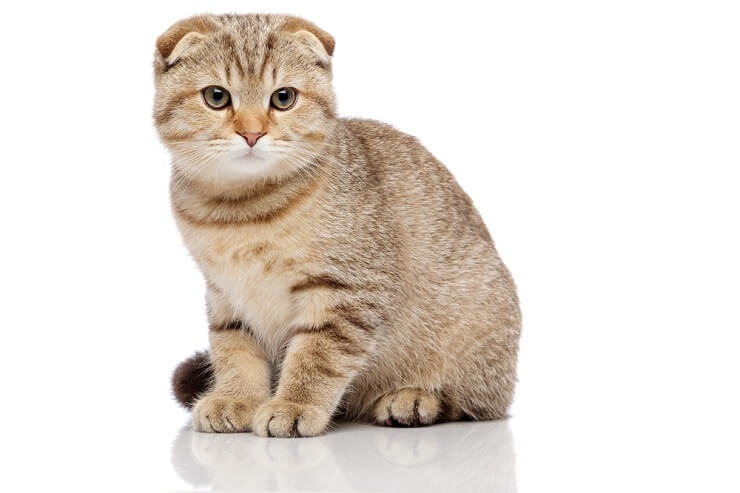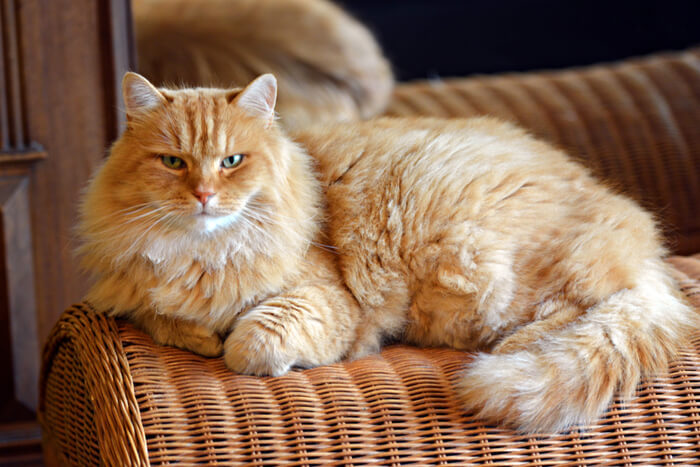8 Oldest Cat Breeds
This page contains affiliate links. We may earn money or products from the companies mentioned in this post through our independently chosen links, which earn us a commission.
Cats have been said to be domesticated as far back as 12,000 years ago. Since Ancient Egyptian times, cats have held a special place in the heart of humans all over the world. To date, there are over 70 recognized breeds of cats but only a select few hold the title of the oldest cat breed.
Here is a list of 8 of the oldest domestic cat breeds.
1. Egyptian Mau
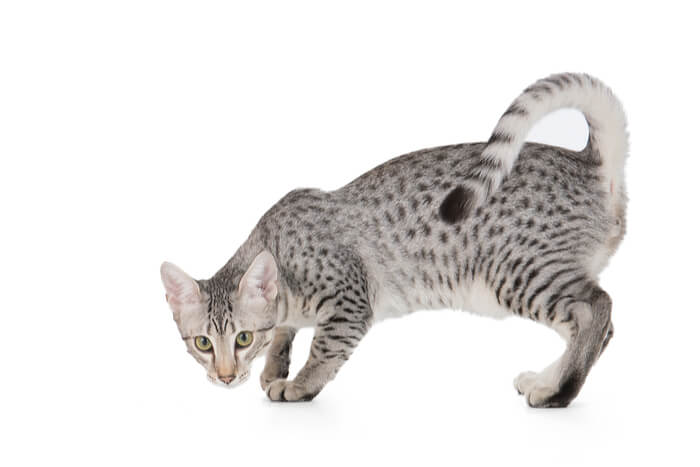
The Egyptian Mau looks about the same as it did 3,000 years ago allegedly. There is artwork depicting cats that look the same as the modern-day Egyptian Mau dating back thousands of years ago. Archaeologists have discovered cats in the tombs of ancient Egyptians that look a lot like todays Egyptian Mau. The Mau may be related to a spotted subspecies of the African Wild Cat.
Egyptian Maus have natural spots on the coat as well as their skin. The Mau displays an athletic body, wedge-shaped head, almond-shaped light green eyes and a coat that comes in silver, bronze and gray colors. Maus take up to two years before reaching physical maturity and weigh between 6 and 14 pounds.
Maus are agile and able to leap six feet in the air from a standing position and run up to 30 miles per hour. They are often regarded as being a bit aloof because they take their time in forming friendships with people and other pets. They are known for being even-tempered and aware of everything that is going on around them.
They are very loyal and devoted to their favorite people. They often show their affection in dog-like ways like waiting at the door to greet their owner when they arrive home as well as bringing a toy for playtime. They often chirp or chortle to get attention or if they see something like a bird outside or an insect crawling across the floor.
2. Turkish Angora
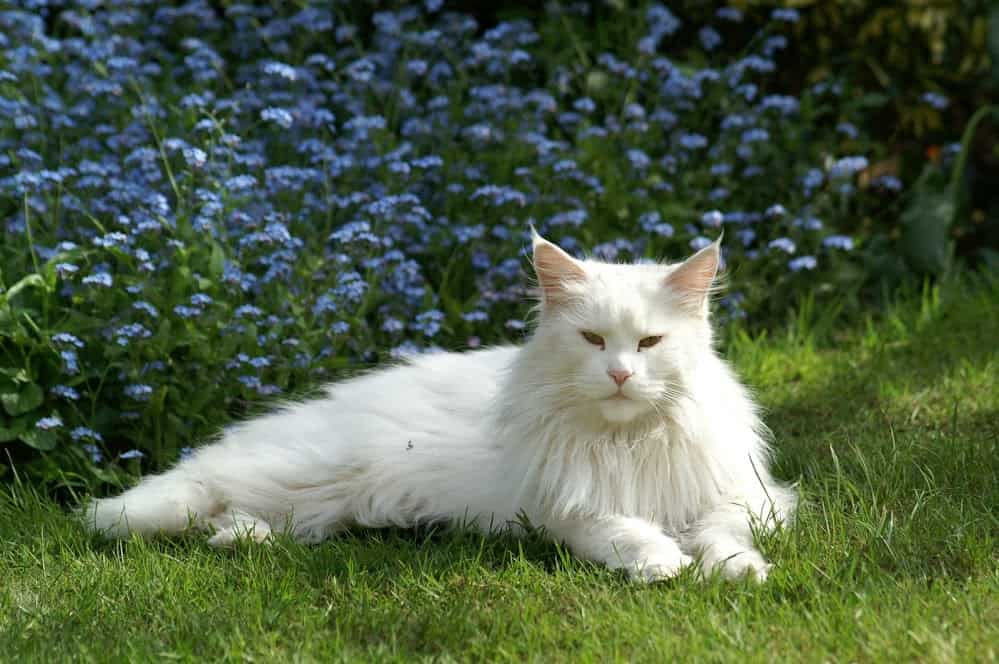
The Turkish Angora is a natural breed that originated in the Ankara region near central Turkey and there they are considered a national treasure. It is estimated that this breed was introduced to Europe by the Vikings, probably during the 10th century. However, it only began to be officially registered in some French writings of the 16th century. It should be noted that the moniker ‘Angora’ was used to refer to many different types of long hair breeds.
The Turkish Angora displays a silky, medium-length coat that comes in a variety of colors, including lavender and chocolate. They have no undercoat. The Angora’s almond-shaped eyes can be blue, green, amber or even odd-eyed (one blue and one amber). This breed has a slender build, fine-boned legs and a silky tail plume that resembles a foxtail. Although similar in looks to its cousin, the Turkish Van, the Turkish Angora is smaller in build and lacks Van’s distinctive markings around the eyes.
The Turkish Angora is an elegant breed and totally devoted to its owners. They are exceptionally intelligent, athletic and welcome challenges. They are curious and thrive on learning commands and tricks. This breed especially enjoys riding around on people’s shoulders or viewing it’s surroundings from high spots, like the top of the refrigerator or doors. They easily welcome the companionship of other pets, including dogs. This breed thrives on acting as “host” of parties and has no problem greeting strangers. However, they can be quick-tempered.
3. Turkish Van
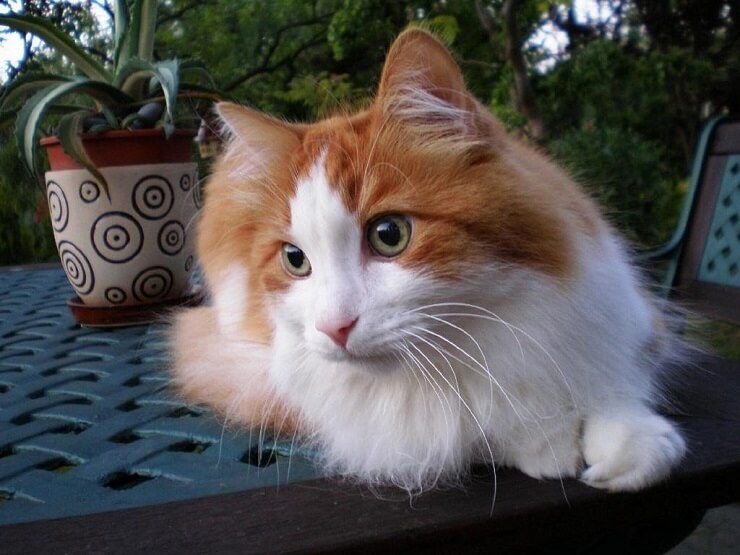
The first of this breed were brought to England in 1955 but identified simply as Turkish cats. The name was later changed to Turkish Van to avoid being confused with the Turkish Angora. The Turkish Van is a native breed not only from the regions near Lake Van in Turkey, but also from central and southwest Asia and southwest Russia. These felines have important cultural value not only to the Turks, but also to Armenian and Kurdish citizens. For this reason, it is often considered a controversial national symbol.
The Turkish Van’s color can be traced to the piebald gene which bestows colored markings on the tail and head with a predominantly white body. The coat features an undercoat and gives off a cashmere-like texture that is water-resistant. Its eyes are large, expressive, set at a slant and can be blue or amber or odd-eyed. Its long, sturdy body is muscular and its head is wedge-shared with prominent cheekbones.
This breed possesses high levels of energy and prefers playtime over sitting in a lap. Even though they are athletic, they demand attention, and love to master tricks for people. They sleep much less than most cat breeds who typically nap up to 17 hours a day.
This cat does want interactions and stimulating toys to prevent from becoming destructive out of boredom. The Turkish Van loves water, so be careful to keep your bathroom door closed or your toilet may be full of toys. This breed is extremely affectionate, but prefers to rub against your leg and not be picked up.
4. Persian
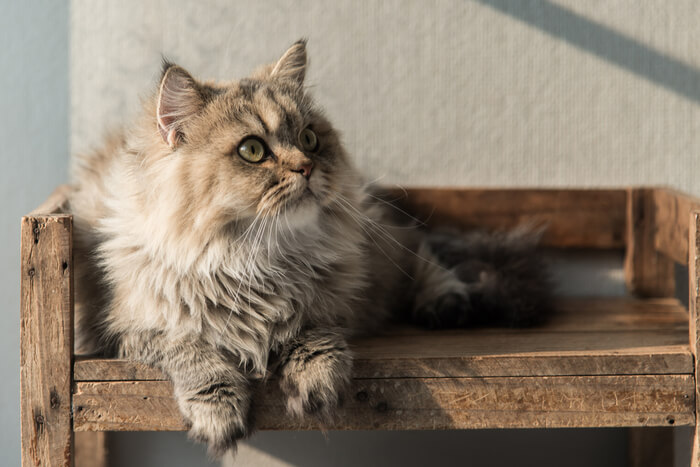
Among the oldest cat breeds, the well-known Persian is depicted in hieroglyphics references dating back to 1684 B.C. and are believed to be developed from longhairs from Persia (now Iran), Burma (now Myanmar), China, and Russia. Long-haired cats were first seen in Europe during the 1400s, but it’s hard to say what exact breed these long-haired cats were. They were almost certainly the ancestors of modern-day Persian cats.
The Persian is known for its trademark long, flowing thick coats. They have a sweet, round face with full cheeks and large expressive eyes contrasted by itty-bitty, round-tipped ears and the toes are heavily tufted. Its short tail is lofted without a curve and at an angle lower than the back. This breed has heavy-boned legs to support medium to large cobby-style bodies.
The Persian’s eyes can be blue, amber or odd-eyed. Blue-eyed Persians are prone to deafness. They are genetically bred to have a snub nose which makes this breed at risk for Brachycephalic issues.
The Persian likes to commandeer laps than show off their leaping abilities but also crave quiet homes, and set routines. They tend to not be fond of surprises, especially noisy houseguests or unruly children. They love to love and display a gentle nature and never over demanding as well as polite. This breed does tend to be well-behaved and not prone to climbing curtains or scaling high shelves. The Persian is not chatty, but when they vocalize, they do so with melodic chirps.
5. Siberian Forest Cat

This cat breed is more commonly known as the Siberian cat. It’s a centuries-old cat breed from Russia. There are claims that the Siberian is the ancestor to all modern long-haired cats and the Siberian is probably very closely related to the Norwegian Forest Cat. Again this is the controversy on where the long-haired cats actually came from. It was one of the only 3 long-haired cat breeds documented during the first cat show in England during the 1700s.
The Siberian’s big, sturdy frame features a dense, triple coat that is designed to weather cold climates. This giant cat breed shows a sweet, beckoning expression with its round eyes, Lynx-tipped ears, round muzzle and full ruff around the neck. It also sports big paws with tufts of fur poking out between the toes and a blunt-tipped tail. The eyes come in many colors, including gold, green and blue. The Siberian’s medium-to-long haired coat comes in a wide range of colors and patterns. The Siberian takes up to 5 years to reach full physical maturity.
The Siberian is extremely attentive and intelligent and born to be a problem solver. This breed loves to learn, and masters obedience commands and tricks easily but also loves an audience. Siberians study and learn how to open cabinet doors and are very capable of leaping up high and enjoy perching on high shelves or even tops of doors to survey the scene. They are gentle around children and adapt easily to other family pets. They tend to be extremely mellow and receptive to people and pets and household guests.
6. Chartreux
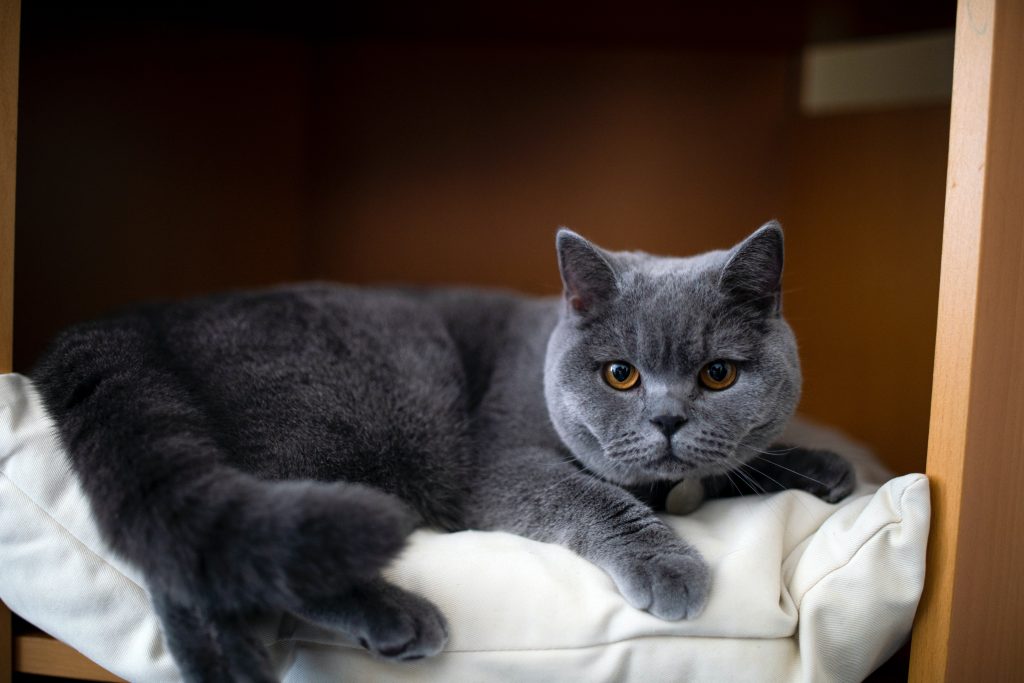
Sometimes also known as a ‘Carthusian’, the Chartreux is one of the oldest cat breeds in the world. French folklore states that this breed was named for the world-renown yellow and green Chartreuse liquors made by the Carthusian monks. Although its creation has been attributed to the French, where it began to be more widely known in the 1930s, it is estimated these cats were introduced to Europe during the Crusades. Today it is believed they originated on the border between Iran and Turkey.
This breed has a wooly, dense blue-grey top coat and a thick undercoat. Most people are captivated by this cat’s gigantic, beckoning eyes of copper or gold as well as its sweet smile. It has full cheeks, straight nose and round ears while the body is big and strong with oversized paws and fine-boned legs. Females weigh between 6 and 9 pounds and are medium in size while males tend to weigh between 10 and 14 pounds and are large in size. The Chartreux takes up to three or four years to fully reach physical maturity.
The Chartreux quietly watches his surroundings and is a quick learner. This breed has earned a reputation through the centuries as being a great hunter, especially with mice. Although it is stocky in size it has a quiet voice, is mellow, adapts to new surroundings and makes for a good travel companion. Some are smart enough to turn on radios, lights and even open doors. This breed can be dog-like and tends to bond with one person in the home and follow them from room to room. However, they are generous with their affection for others as well. This cat prefers to leave the scene rather than be confrontational when there is a conflict.
7. Abyssinian
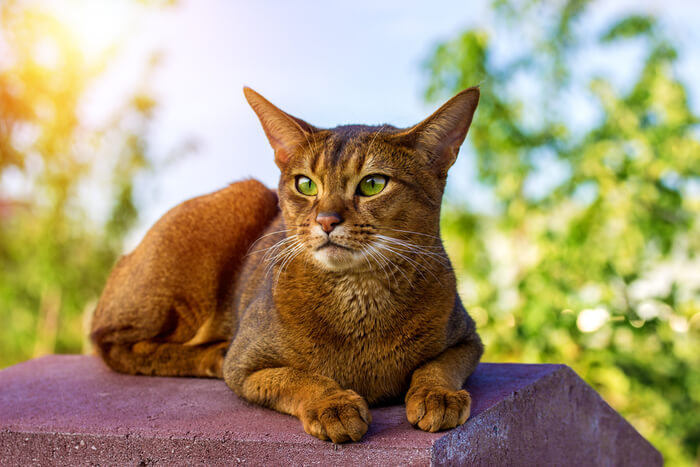
Out of all the ancient cat breeds out there, this one seems to have a lot of debate about its history. The Abyssinian is one of the oldest known cat breeds, dating back to ancient Egypt 4,000 years ago. Some say that the Abyssinian is a cat breed from ancient Egyptian times because it looks similar to artifacts from that time period. Of course, the modern Abyssinian is much different than its ancestors. The ones we see today were bred with Burmese, Russian Blue, and Siamese cats.
The Abyssinian’s body is long, lean and muscular on fine-boned, long legs. It has a wedge-shaped head, expressive almond-shaped eyes and oversized pointed ears and tabby “M” on the forehead. The coat sports a ticked or agouti pattern highlighted by alternating bands of color on the hair shafts that give off a translucent quality.
The Abyssinian loves to master tricks for people and is very athletic. It likes to study the actions of people and learns. They are fast and agile, capable of soaring 6 feet in the air and enjoy perching on shoulders as well as tall shelves and other high places. This breed is very curious, and can use its paws to open cabinet doors and turn on light switches and it’s best for you to keep breakables out of paw’s reach.
Loyal and affectionate, but demanding, the Abyssinian can become easily bored. They need interaction and home-alone toys as well as suitable exercise outlets like floor-to-ceiling scratching posts and wand toys to stalk.
8. Korat
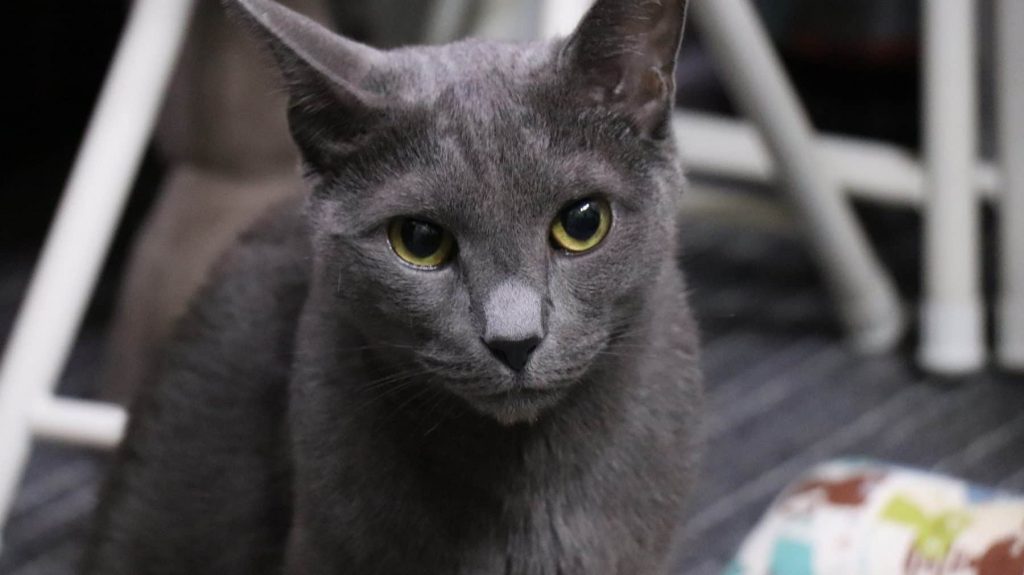
The Korat, often known as the ‘lucky cat’, is originally a native breed from Thailand. This breed is officially recognized by the government of Thailand as a national treasure. Records of the first date back to the year 1350 CE. These kittens drew attention not only for the beautiful blue color of their fur and the green of their eyes, but for also being one of the smallest domesticated cats in the world.
The Korat is a muscular breed and sports a heart-shaped head along with huge, luminous green eyes and a lion-looking downward curve of the nose. Its cobby-shaped body is medium-sized and muscular with its front legs slightly shorter than the hind legs. Their medium-length tail is fuller at the base and tapers to a rounded tip. It has a short-haired, single coat that is a fine texture with a glossy look. The only Korat color accepted in cat show competition is blue, which is actually silver-tipped. Korats do not fully mature until age five.
The Korat has been known to bond to their family and home and prefers quiet households and being catered to by his people. They are known for extreme intelligence and problem-solving skills but also capable of learning specific words and engaging in conversations using a variety of expressive sounds. The Korat is very curious and dexterous, capable of pawing open cabinet doors. They can be a bit cautious, which can be misconstrued as being aloof and they do like to be the only pet or may become territorial and bossy toward other pets in the home.
Final Thoughts
There is our list of the oldest cat breeds and some of them are even thousands of years old and have interesting backgrounds and histories.


